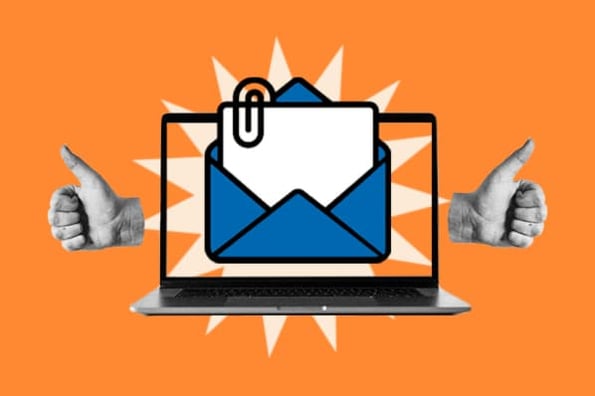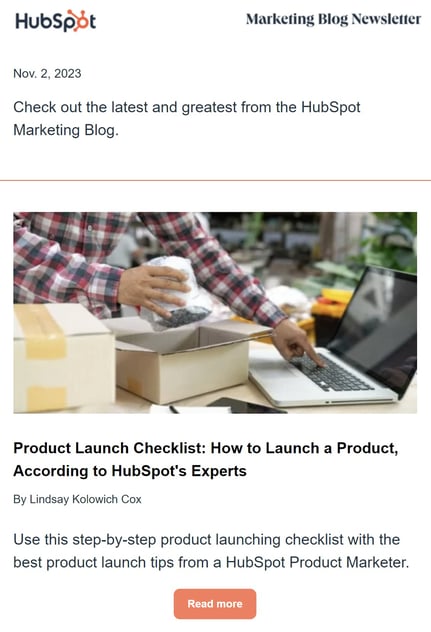I send the HubSpot Marketing Emails every day, so I’m pretty familiar with the types of marketing emails marketers can leverage. However, which ones gain the most engagement and which do not?

To answer that question, and to pass that knowledge on to you, we ran a survey with Glimpse, asking marketers which types of emails achieve the highest performance.
Here’s what I found:
4 Types of Emails That Get the Most Engagement
The four emails get the most engagement, according to our latest Glimpse survey.
1. Multimedia Emails
Multimedia emails include videos, photos, GIFs, and other elements to make its content stand out. 44% of the marketers in our survey say multimedia emails get the highest engagement.
It makes sense because a variety in media gives consumers more dynamic content to interact with and is more appealing than emails with only text.
For example, Society6 sent the below email featuring GIFs of dancing phones with changing cases to showcase the variety of cases available on the website.
It also features moving text with changing colors to emphasize the phrases “Today Only” and “Flash Deals.”

2. Basic Emails
When I think of basic, I usually think “boring,” but that doesn’t have to be the case with these emails.
39% of marketers say they get the most engagement through basic email formats that highlight a list of links, articles, or pages to click on with light imagery.
For example, this email I received from Amazon Prime highlights links to the films on its platform with clickable images that take me to where it’s available to stream.

Incorporating photos in your emails will help illustrate the products, services, or information you’re trying to convey and entice readers to click.
3. Discount Emails
Our survey found almost a third of marketers (31%) say emails promoting coupons, discount codes, free resources, or sales get the most engagement. Who doesn’t love a chance to save money?
Bear in mind, however, that the secret to the success of these emails isn‘t just their content; it’s also in their subject lines.
I get promotional emails highlighting deals all the time in my own inbox, and something I’ve noticed is that almost every subject line includes quantitative information about these coupons, discounts, and sales. See the example below.

Notice all the subject lines read:
- “50% off Art Prints”
- “Earn $7 rewards”
- “25% of everything”
- “Up to $100 off”
Include quantitative information about deals in the subject line to immediately let subscribers know why they should click and open your email.
5 Types of Emails That Get the Least Engagement
For context, our surveys asked marketers to name the point out the types of emails that gain the most engagement. The emails in this list are mentioned because they got the least amount of votes from marketers.
1. Product/Service Announcement Emails
Only 24% of marketers say emails announcing new products yield the most engagement. That said, I still find a lot of value in sending product and service announcements via email — you just have to do it right.
To make your product/service announcement emails stand out in your recipients’ inboxes and boost their engagement, really lean into personalization.
Use the information you have about your consumers to send targeted product emails that are relevant to the recipient. For example, let‘s say you’re a pet supply store.
If you‘re selling a new cat toy, only send that product announcement to cat owners on your email list or to recipients who often buy cat supplies. And if you’re now offering dog grooming services, only send the information to subscribers who often purchase dog supplies.
2. Article-Style Emails
Only 23% of marketers in our survey say article-style emails with original content yield the most engagement.
Admittedly, it’s not my favorite type of email to receive. Like most consumers, I only spend a few seconds reading an email to scroll to the next or go about my day.
In fact, people spend, on average, only 9 seconds reading an email. So, article-style emails aren’t the most fruitful emails marketers can send nowadays.
Instead, I suggest doing what I do for the HubSpot Marketing Emails: include a short excerpt of articles or blog posts in the email and include clickable links and images so readers have the option to read the full article on your website.
Even if recipients don‘t read the full article, they’re at least more likely to click and go to your website.
 3. Emails Promoting Contests/Competitions
3. Emails Promoting Contests/Competitions
This took me by surprise because I love a chance to win, but only 18% of marketers said emails promoting contests and competitions yield the most engagement.
However, I wouldn’t let that statistic dissuade you from leveraging contests and competitions in your email marketing campaigns. Instead, make your contests interesting and fun for your audience to encourage participation.
For example, I recently received an email from Canva challenging subscribers to design a mood board using the graphic design platform’s tools. If I make a mood board and share it with Canva, I could win a prize.
To make the competition more interesting, Canva says users must showcase their work on Instagram and X (formerly Twitter) along with the brand’s hashtag #CanvaDesignChallenge for a chance to win.
Canva can then repost and share these creations as user-generated content.

It’s a clever idea because the challenge does the following:
- Creates a fun and engaging experience for users
- Showcases the brand’s tools and features
- Boosts brand awareness on social media via hashtags and content sharing
- Leverages user-generated content
So, to get the most out of your email contests and competitions, integrate social media and user-generated content in a way that is simple, engaging, and fun for recipients. Furthermore, use the competition as an opportunity for recipients to experience aspects of your product or service.
4. Educational Emails
Just 17% of marketers say educational emails about their industry rather than products or services get the most engagement.
This makes sense because consumers are typically less concerned with industry insight than they are with the products and services that could benefit them.
If you want to leverage these kinds of emails, make sure you let you audience know how the information benefits them and tie it back to the products and services you offer.
For example, this email from InVideo shares a quick blurb of valuable information:
“The use of apt text and text styles in videos can have a positive impact on several metrics, including watching time, engagement, and overall retention.”
The email then ties the information back to its service with a call to action:
“Find one that best goes with your content.”
The text is followed by an image showing the different kinds of text and text styles available on the platform.

In a way, the email presents a possible problem (you need the right apt text and text style), and then it presents the company’s products/service as a solution (look at all the text options they have).
Do the same in your own educational emails.
5. Event Announcements
Finally, only 10% of marketers say emails announcing events, such as conferences, livestreams, and webinars get the most engagement. To boost the engagement of these kinds of emails, follow the same advice I gave for educational emails.
For example, let’s say InVideo is hosting a webinar about choosing the right text style for videos. The email could have the same email message as the one above:
“The use of apt text and text styles in videos can have a positive impact on several metrics, including watching time, engagement, and overall retention.”
This time, however, the email could then say:
“Sign up for our webinar to learn how to choose the right apt text or text style for your next video.”
InVideo could also sweeten the deal by offering email recipients 20% off on some of its features in exchange for signing up for the webinar.
What I‘ve learned as an email marketer is that the type of email you send will depend on the goal of your email campaign and type of content your recipients respond to. I’ve also learned every email has to offer value to your consumers.
So, make sure every email you send out ties back to what solutions your organization provides. Keep this in mind, and you’ll surely have a successful email marketing campaign.
- SEO Powered Content & PR Distribution. Get Amplified Today.
- PlatoData.Network Vertical Generative Ai. Empower Yourself. Access Here.
- PlatoAiStream. Web3 Intelligence. Knowledge Amplified. Access Here.
- PlatoESG. Carbon, CleanTech, Energy, Environment, Solar, Waste Management. Access Here.
- PlatoHealth. Biotech and Clinical Trials Intelligence. Access Here.
- Source: https://blog.hubspot.com/marketing/types-of-emails



